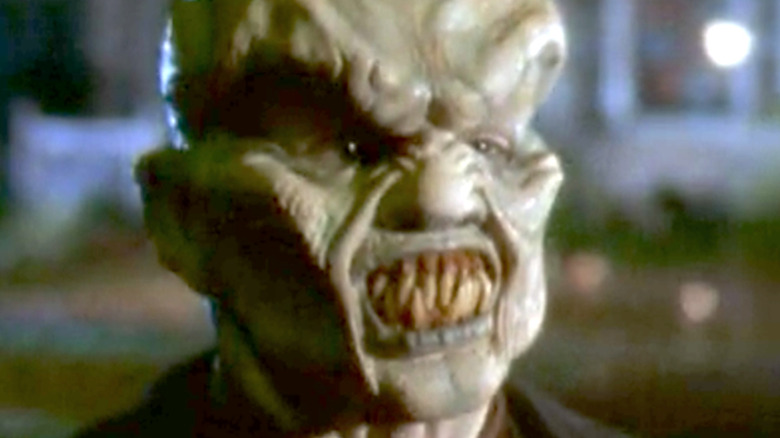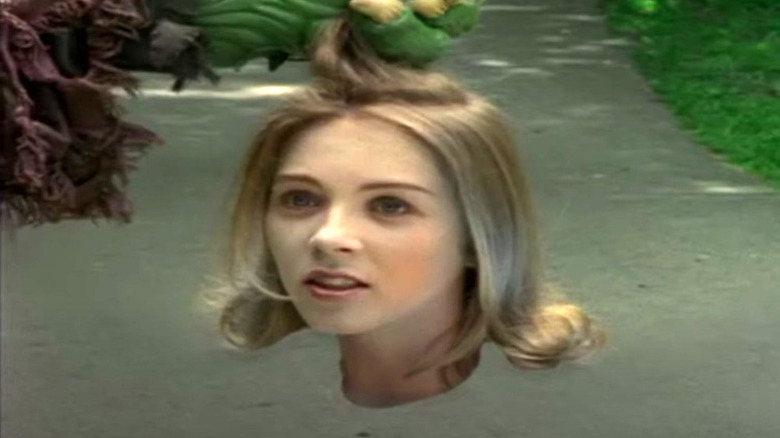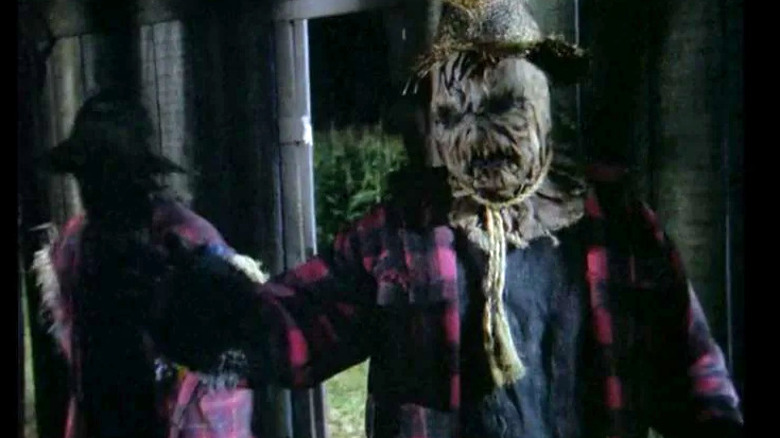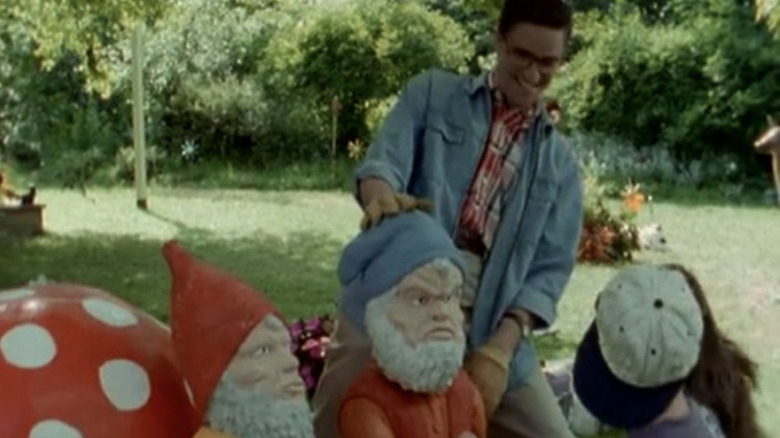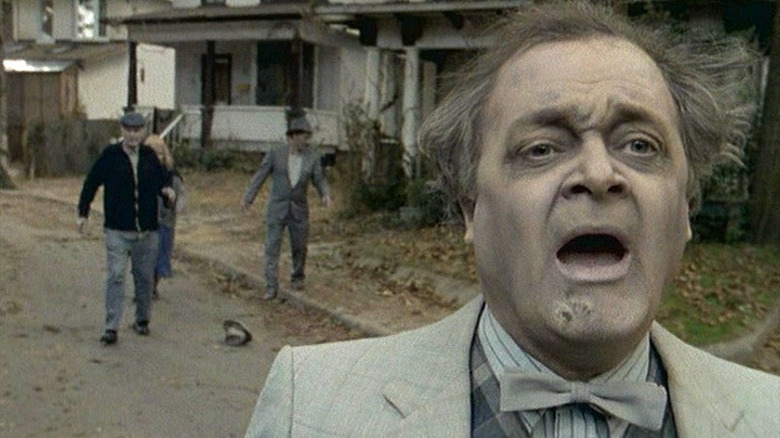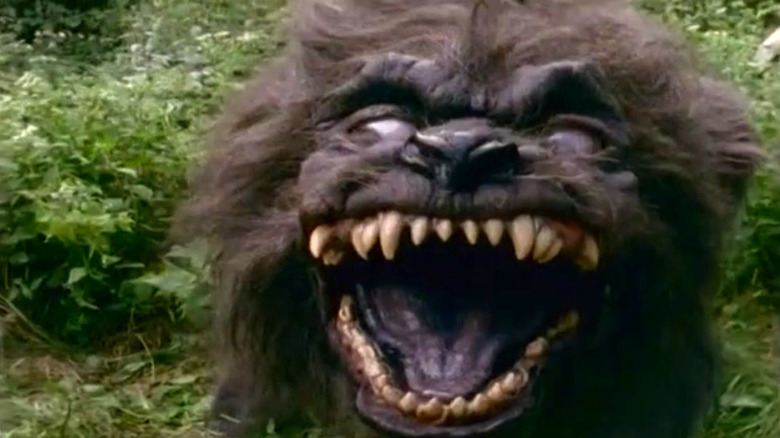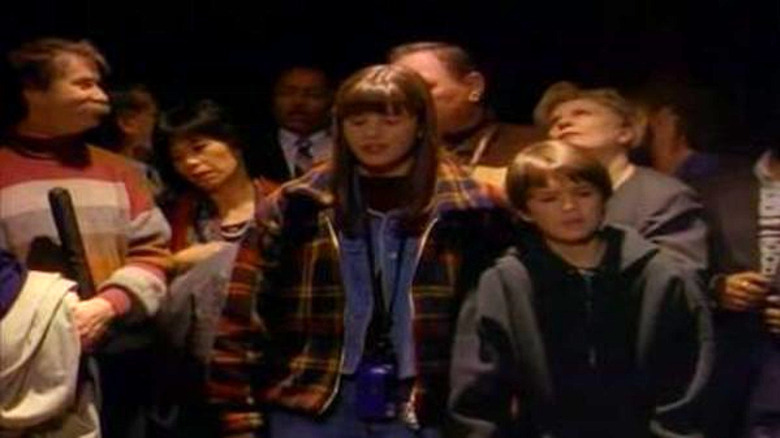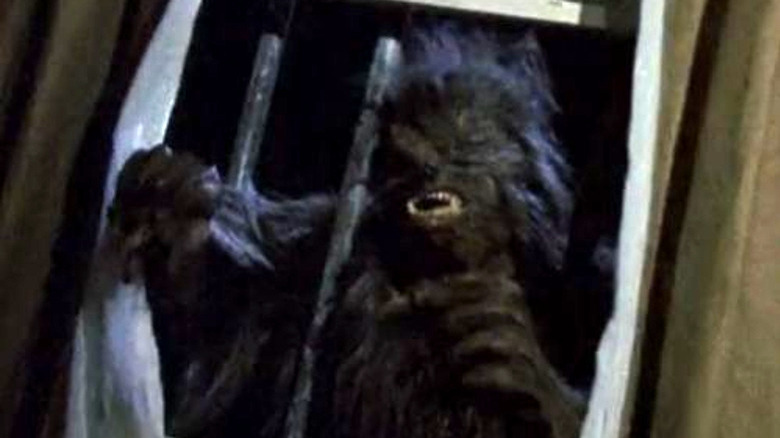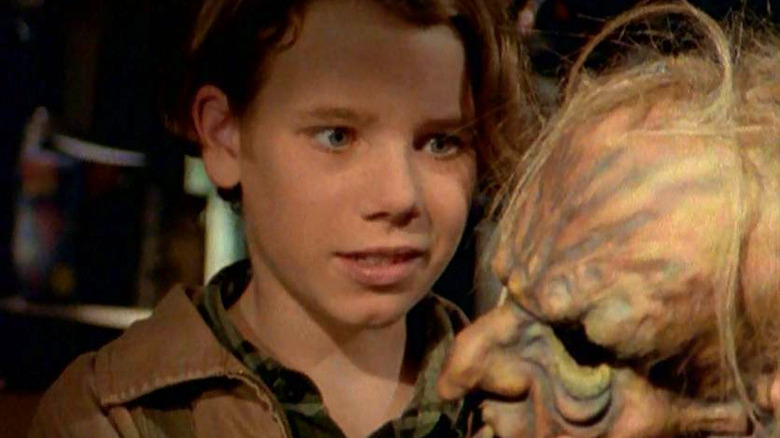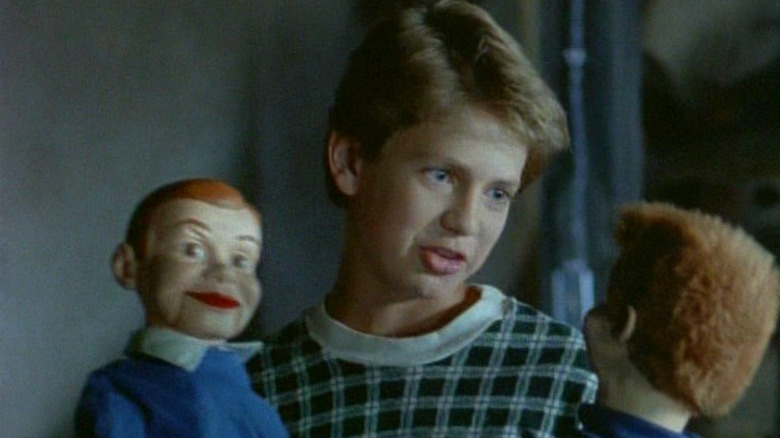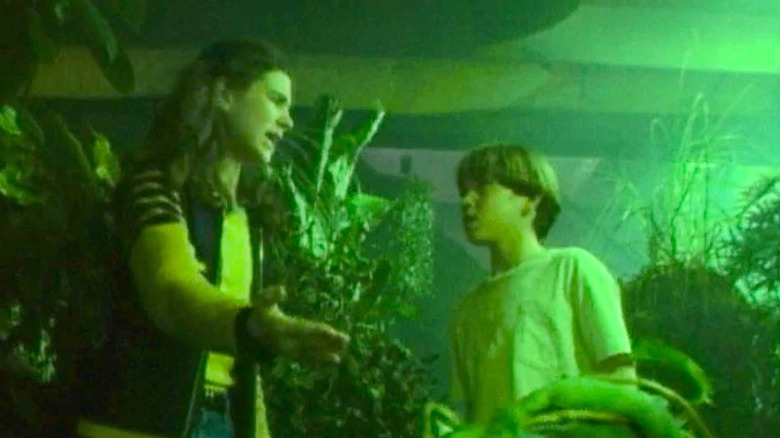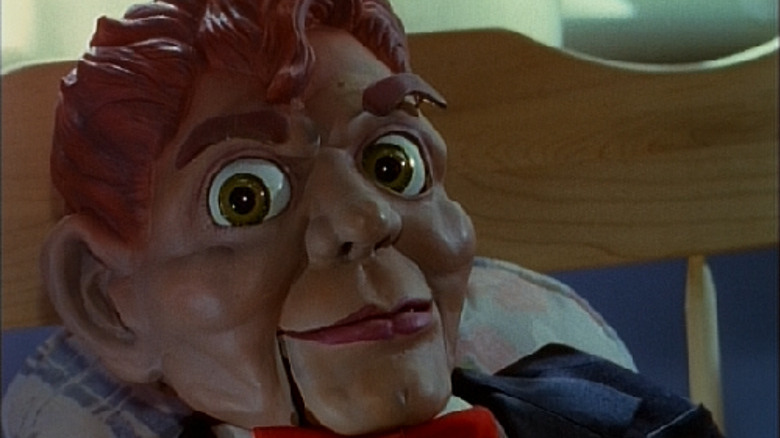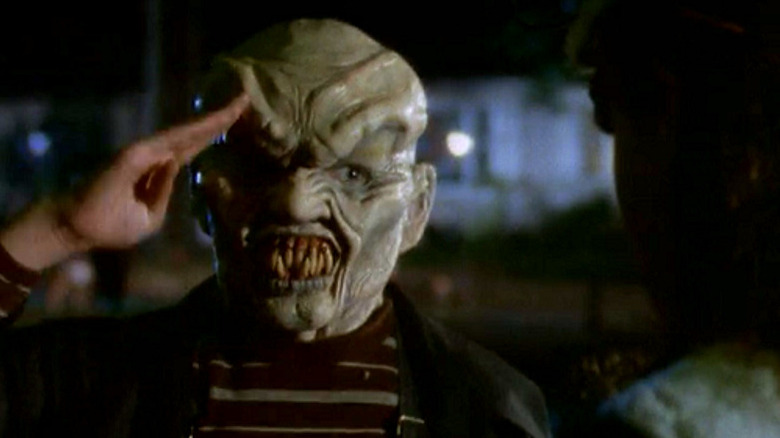The Best Episodes Of Goosebumps Ranked
The "Goosebumps" books dominated the reading shelves of 1990s schools. Author R. L. Stine tapped into a gold mine by crafting suspenseful books for kids who craved stories with some edge but weren't ready for Jason Voorhees or Freddy Krueger. Of course, Stine never went too far, and the safety of his characters is rarely in doubt. But just like a haunted house attraction at Halloween, the suggestion of danger was enough to give Stine's readers ... goosebumps.
While the book series was at its peak, a television series was created that adapts several of the novels to the small screen. For ravenous "Goosebumps" readers, the series was a chance to see their favorite stories come to life. While most episodes struggled under the weight of their lackluster budgets and fail to do the source material justice, there are plenty that nail their story's execution and still hold up fairly well decades later.
Although the franchise isn't as ubiquitous as it was 30 years ago, "Goosebumps" has never really gone away. There's still a desire to relive the thrills of childhood fright, as demonstrated by the release of two feature films — namely "Goosebumps" and "Goosebumps 2: Haunted Halloween" aka "Slappy's Revenge" — and Stine collaborating with his "Goosebumps" cover artist A.L. Kaplan on the comic book "Stuff of Nightmares." So let's look back at the show and rank the very best episodes for new viewers interested in diving in, as well as classic fans hoping to experience the horror of their youth all over again.
One Day at Horrorland
Most of the entries on this list are two-parters. This could be because the extended running time allows for the folks involved in the show to dig a little deeper into the stories. Telling one story over a pair of episodes might have increased the budget as well, since these longer episodes tend to look a little more polished than the standalones. The major exception to this rule is "One Day at Horrorland."
Although the episode is stuffed with terrific monster designs, the rest of it looks pretty cheap and the story is about as shallow as a puddle. It's about a family on vacation who stop to visit an amusement park called Horrorland. Nothing particularly scary happens, but the family eventually pieces together that something strange is going on. Their attempts to solve the mystery make up the bulk of the plot.
What "One Day at Horrorland" lacks in story and character, it makes up for in wild imagery. One of the first things the family encounters when entering the park is a monster carrying a severed human head. This head turns to them and warns them about the danger ahead (pun intended). It's a ridiculous image that perfectly sets up the bizarre tone that only gets sillier and weirder as the tale unfolds.
The Scarecrow Walks at Midnight
Inanimate objects coming to life and exhibiting malicious intentions, for some reason, describes the narrative crux of a few entries on this list. Mechanical appliances and such things we all take for granted becoming self-aware and wanting to punish us is a timeless statement on humanity's hubris. If you get it right, like "Frankenstein" or "Terminator" or the first season of "Westworld," the story goes on to become a classic. If not, it vanishes from public consciousness.
"The Scarecrow Walks at Midnight" is neither classic nor forgettable. It walks the line well enough that you're engaged from start to finish, but ultimately left underwhelmed. It's got a great setup — two siblings are pumped about spending the summer on their grandparents' farm. However, they're not getting the chance to do all the fun stuff they usually do, as something vaguely scarecrow-related has their grandparents spooked.
The episode looks good; the farm feels authentic, and the design of the scarecrow is suitably creepy. The scene in which one of the scarecrows breaks into the barn is tense and could easily frighten young viewers, but there's very little mystery here. Had the show tried to keep the nature of this menace a little more obscure, the story might still work as a spooky piece of entertainment. Unfortunately, it never quite lives up to its premise. Still, there's enough good here to add it to the list.
Revenge of the Lawn Gnomes
Another episode about inanimate coming to life and causing trouble is "Revenge of the Lawn Gnomes." The Burton family has one of the tackiest gardens on the block thanks to all of Mr. Burton's corny ornaments. However, he's still determined to win the summer gardening contest and fully expects his new lawn gnomes to seal the deal. What he doesn't know is, as his daughter later explains, "They're lawn gnomes by day, but in the dark, they're just plain gnomes."
This episode edges out "Scarecrow" because it takes a little time to set up its mystery. We've got a pretty good idea that the gnomes are the ones destroying the neighbors' garden, but watching the characters figure that out is where the suspense comes in. Also, the episode makes the gnomes more menacing than they are the book version of the story with a twist we won't spoil here.
"Revenge of the Lawn Gnomes" is a great example of what the show can be when it's allowed to be weird and doesn't reveal all of its secrets within the first few minutes.
Welcome to Dead House
The first book in the "Goosebumps" series is something of an outsider. While many of the hallmarks of the series are present, there are glaring differences in terms of tone and threat level, and that carries through into TV version of "Welcome to Dead House." The story is a few shades darker than most of the others, with far less humor. The style of the production reflects this by making everything look gray, muted, and a little ugly, unlike the typically colorful and zany look of most of television's "Goosebumps." Also, the concept itself is more sinister than you might initially suspect. Unlike most stories about a family moving into a haunted house, there is far more going on here than a menacing spirit making their lives difficult. There's no murder to solve that will let the spirit rest or a ritual they can perform to scare the supernatural being away. The threat goes deeper than any of that.
This wouldn't be a very good episode to start with if you're interested in checking out the series, as it's not representative of the rest of the batch. But if you just want to watch a strong and effective dark tale of the supernatural with no gore or violence, you could do a lot worse than "Welcome to Dead House."
Welcome to Camp Nightmare
The horror genre is much more malleable than some folks care to admit. All the label "horror" means is fictional content that attempts to horrify its audience in some way. Whether the story is grounded in reality or focused on the fantastic, as long as it's trying to frighten you in some way, it's a horror story. The genre encompasses a multitude of horror subgenres, and "Welcome to Camp Nightmare" dips a toe into pretty much all of them.
The kids in "Camp Nightmare" start off with all the same worries as any normal set of kids going off to summer camp – anxiety over being away from home, fears about making friends, and worries about mean camp counselors. Then things change. Suddenly, campers go missing and counselors act like they never existed. Trying to unravel this complex web of lies reveals all sorts of bonkers plot twists and tonal shifts that might truly bewilder the audience.
Of course, the time comes when all is revealed, and the confusion dissipates. But no matter how prepared you think you are for this story's final reveal, you are not. Just when you think this story has covered every subgenre it possibly could and you've got the whole thing pegged, the carpet is pulled right out from under you, and nothing makes sense anymore.
A Night in Terror Tower
While visiting England, siblings Eddie and Sue are touring Terror Tower when they start seeing strange apparitions. Is the tower haunted? Are the historical displays coming to life? What's any of that got to do with the fact that they can't remember their parents or their own last names? Who is the bearded man chasing after them? Those are the questions plaguing the protagonists and the viewers in this huge two-part story.
Whether or not you enjoy the episode will likely have to do with how you feel about the mystery's conclusion. The story spends a lot of time introducing plot elements that it pays off in the second half, but its execution might leave some audience members disappointed. However, if you can roll with an unconventional plot twist, you'll have a good time. If nothing else, you can appreciate the fact that "Goosebumps" is trying to tell a larger story than usual, and the production quality reflects that ambition.
The Werewolf of Fever Swamp
A family moves to Fever Swamp to conduct an experiment involving deer adapting to a new environment. The place is a dump, but at least they've got a new dog. However, when animals start showing up dead, the new pet is blamed. Grady knows the truth, though; there is a werewolf in Fever Swamp.
Like "Welcome to Dead House," "The Werewolf of Fever Swamp" feels closer to a work of grown-up horror, with a darker tone and grittier look than other "Goosebumps" episodes. Very little is played for laughs. Had the characters been a little older and the violence stronger, this could have easily been an unqualified horror short meant for teens and adults.
Oftentimes, the young actors in "Goosebumps" sound like they're reading their lines for the very first time. Here, they're very believable, especially Brendan Fletcher as Grady. He feels like a genuinely frustrated kid with a bit of a dark side. He's written just like any other character in the series, but he carries enough gravitas to make his character more realistic.
The misdirect involving the swamp hermit (Stine loves his red herrings) is obvious, but that doesn't distract from the viewing experience. Give this one a watch some evening with a bag of popcorn, and you might find yourself sucked into the strange and spooky world of Fever Swamp.
The Haunted Mask II
When observing the evolution of horror franchises, there's a discernable pattern of sequels tending to drift into silly or absurd territory. While the original installments of "Friday the 13th," "A Nightmare on Elm Street," "Hellraiser," and "Child's Play," all tap into simple, universal, and primal fears, many of their sequels eventually veer off and turn strange, unhinged, or flat-out ridiculous.
The same can also be said for "The Haunted Mask II." Although the original "Haunted Mask" uses the paranormal as a way of addressing identity and losing yourself to rage, the sequel commits to the mythology surrounding the first story. The bullies from the original entry are bored with the same old tricks. They love to scare people, but it's getting tired and they're aging out of Halloween. The only cure is to up their game. So, they seek more masks like the one Carly Beth wore the previous year.
It's interesting that the sequel chooses to focus on the antagonists this time around, and it's great to see how Carly Beth has grown from her experience. Other than that, though, most of the fun in this story comes from the wonderful Halloween atmosphere and the sheer goofiness of the mythology.
Night of the Living Dummy III
The living ventriloquist dummy Slappy has become the "Goosebumps" mascot over the years, usurping Curly the skeleton. It isn't difficult to see why. For one thing, unlike Curly, Slappy actually appears in the books. He's also a fantastic image. As cool as Curly is in a blatantly derivative of the Crypt Keeper kind of way, he didn't really represent the series. "Goosebumps" is primarily about seemingly mundane things becoming menacing or fantastical; a living dummy simply fits the bill.
"Night of the Living Dummy III" — Slappy's second appearance on the show — is another example of a horror franchise just going for ridiculousness with its sequels, and that's not a bad thing. In this installment, Anakin Skywalker himself, Hayden Christensen plays Zane, a sensitive kid who always gets picked on by his cousins. While spending some time at their house, he thinks his bratty cousins are playing tricks on him. But with Slappy in the house, the audience knows better.
There isn't much here for the viewers to be scared of unless they really don't like dummies. Everything about the episode is so silly that it would be hard to imagine anyone, even the youngest members of the target audience, falling for its fake-outs and warmed-over tropes. Still, the over-the-top tone and strange performances, not to mention the charisma of Slappy, plus that bonkers ending make this one of the most entertaining entries in the "Goosebumps" cannon.
Stay Out of the Basement
"Stay Out of the Basement" wastes no time setting the tone. The wind blows dead leaves across the scene as Margaret pleads with her mother not to leave. Sure, her aunt is sick and needs someone to look after her, but there's something wrong with Dad. He spends all his time in the basement doing botany experiments and acting super weird. Her mom and little brother assure her she's just overreacting, and Dad is simply trying to get his job at the university back.
Right from the jump, we're thrown into this situation where the main character is terrified that something bad is going to happen. The suspense only builds from there as we learn that Margaret's concerns were entirely justified, and her father really is changing. It's an effective setup and progression that makes these two episodes cruise by at a clip, keeping you hooked the whole time.
Thanks to presumable shortcomings in the special effects budget, the scenes in the basement are interesting in concept but laughable in execution. With better visuals, this episode might have made it to the top of this list. Unfortunately, it doesn't quite reach the heights its potential promises, but it's still an excellent entry point for a new viewer or a fan starting a rewatch.
Night of the Living Dummy II
Don't let the title fool you; "Night of the Living Dummy II" is the first appearance of Slappy in the series. The original book, "Night of the Living Dummy" features the introduction of Slappy, but he isn't the main antagonist. In fact, he doesn't pose a threat until the end of the story when the real villain, Mr. Wood, gets run over by a steamroller. Since Slappy is so synonymous with "Goosebumps" it makes sense to adapt the second book first. Why didn't they simply retitle the episode "Night of the Living Dummy" to avoid confusion? That's a real mystery.
Despite this being a standalone episode, the pacing is impeccable. There isn't a bit of padding, and nothing is rushed. You really get the chance to sit with Amy and get a sense of what makes her tick before Slappy slowly starts to ruin her life. After receiving Slappy as a gift, Amy gets to work on perfecting her ventriloquism act. Soon, strange things start happening, and Amy is the one who gets blamed.
After Slappy starts talking by himself during Amy's act, she realizes he's the one responsible for what's been happening. She tries to convince her family, but no one believes her. She tosses Slappy into the sewer, but he comes back. The scenes where Slappy terrorizes Amy are tense and suspenseful. "Night of the Living Dummy II" earns its moments by not giving everything away too early, making this one of the all-time best episodes.
The Haunted Mask
"The Haunted Mask" is the best episode of "Goosebumps" for several reasons. For one thing, the concept is genius: an anxious girl who scares easily plans to get revenge on her tormentors by wearing a terrifying mask she stole from a mysterious shop. The longer she wears the mask and gives in to her rage and appetite for vengeance, the more she loses herself. The mask literally starts to overtake her.
Despite its relatively young demographic, this episode isn't afraid to be disturbing. When Carly Beth realizes that the mask is sweating and has fused to her skin, she panics. It's an intense scene that conjures images in the mind of the viewer that could make their skin crawl. At one point, she buries a ceramic sculpture of her own head made by her mother, symbolizing the death of Carly Beth. Demonic laughter erupts as she taunts her old, cowardly personality. It's scary as heck.
All the performances are really strong in this one, with only one or two weak links popping up. On top of that, the Halloween atmosphere is rendered exceptionally. "The Haunted Mask" looks and feels like an ideal Halloween, making it perfect October 31st viewing. Apparently, someone at Fox Kids agreed, because this episode premiered on October 27th. Overall, "The Haunted Mask" is a fantastic story and viewing experience.
